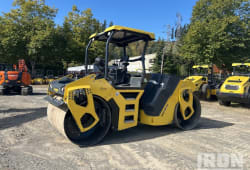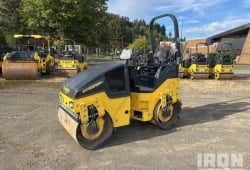Strategies in Managing Fatigue-Related Hazards for Heavy Equipment Operators
13 Lectura mínima
)
agosto 11, 2023
Fatigue is a serious concern for heavy equipment operators. The demanding nature of their work combined with long hours and physically strenuous tasks can lead to increased fatigue levels. In this article, we will explore the various aspects of managing fatigue-related hazards for heavy equipment operators and the strategies that can be implemented to reduce the risks associated with fatigue.
Understanding Fatigue in Heavy Equipment Operators
Fatigue may be defined as a state of physical or mental exhaustion that significantly impairs performance. It is a complex phenomenon influenced by various factors, including inadequate rest, poor sleep quality, extended work hours, and more. Understanding the impact of fatigue on performance is crucial for effective fatigue management.
Defining Fatigue and Its Impact on Performance
Fatigue can manifest in different ways, including reduced alertness, slower reaction times, impaired decision-making abilities, and decreased situational awareness. These impairments can compromise the safety of heavy equipment operators and increase the likelihood of accidents and incidents.
When heavy equipment operators experience fatigue, their ability to focus and concentrate on the task at hand is diminished. This can lead to errors in judgment, slower response times, and decreased productivity. In high-risk environments where precision and quick decision-making are crucial, fatigue can have severe consequences.
Furthermore, fatigue not only affects the physical aspects of performance but also the mental and emotional well-being of operators. Prolonged periods of fatigue can lead to increased stress levels, irritability, and decreased job satisfaction. This can create a negative work environment and impact overall team morale.
Common Causes of Fatigue in Heavy Equipment Operators
Several factors contribute to fatigue in heavy equipment operators. First and foremost is the demanding nature of their work, which often involves operating heavy machinery in challenging environments. The constant exposure to vibrations, noise, and harsh weather conditions can take a toll on their physical and mental well-being.
In addition to the demanding work environment, long working hours and irregular shifts can disrupt the body's natural sleep-wake cycle, leading to sleep deprivation and fatigue. The irregularity in work schedules can make it challenging for operators to establish a consistent sleep routine, further exacerbating the problem.
Furthermore, inadequate rest breaks during shifts can prevent operators from fully recovering and recharging their energy levels. Without sufficient time to rest and rejuvenate, fatigue can accumulate over time, leading to chronic exhaustion.
Poor sleep quality is another significant contributor to fatigue in heavy equipment operators. Factors such as uncomfortable sleeping conditions, excessive noise, and sleep disorders can disrupt the quality of sleep, leaving operators feeling tired and unrefreshed even after a full night's rest.
Organizations need to recognize and address these common causes of fatigue in heavy equipment operators to ensure their safety and well-being. Implementing strategies such as regular breaks, adequate rest periods, and promoting a healthy work-life balance can help mitigate the risk of fatigue-related incidents.
The Dangers of Fatigue in Heavy Equipment Operation
Fatigue-related accidents and incidents pose a significant threat to the safety of heavy equipment operators and those working around them. The consequences of these incidents can range from equipment damage and increased downtime to severe injuries or even fatalities. Moreover, the costs associated with fatigue-related hazards are not limited to financial implications, but can also include reputational damage and legal consequences.
Operating heavy equipment requires the utmost focus and attention to detail. However, when fatigue sets in, these essential qualities become compromised, putting both the operator and others at risk. It is crucial to understand the various factors that contribute to fatigue in heavy equipment operations and take proactive measures to mitigate its effects.
Fatigue-Related Accidents and Incidents
Research has shown that fatigue significantly increases the risk of accidents and incidents in heavy equipment operations Fatigue impairs cognitive and physical abilities, leading to decreased concentration, slower reactions, and compromised decision-making. These impairments can have disastrous consequences in a high-risk work environment.
Imagine a scenario where a fatigued equipment operator fails to notice a warning signal, resulting in a collision with another vehicle or a stationary object. The impact of such an incident can be catastrophic, causing severe damage to the equipment, injuries to the operator, and potentially endangering the lives of others nearby.
Furthermore, fatigue-related accidents can have far-reaching consequences beyond immediate physical damage. They can lead to legal battles, insurance claims, and reputational harm for the company involved. Clients and stakeholders may question the organization's commitment to safety, potentially impacting future business opportunities.
The Cost of Fatigue-Related Hazards
The financial costs associated with fatigue-related incidents are substantial. They include insurance claims, medical expenses, repairs, and replacement costs for damaged equipment, fines, and legal fees, and potential increases in insurance premiums. Additionally, fatigue-related incidents can result in increased downtime, disrupted schedules, and decreased productivity.
Consider the ripple effects of a fatigue-related incident. The damaged equipment may require extensive repairs or even replacement, leading to significant financial burdens for the company. The injured operator may require medical treatment and rehabilitation, resulting in mounting medical expenses.
Furthermore, the downtime caused by a fatigue-related incident can disrupt project schedules, causing delays and potential financial penalties. The productivity of the entire team may be compromised as they wait for the equipment to be repaired or replaced, affecting overall project efficiency.
Organizations must recognize the true costs of fatigue-related hazards and invest in comprehensive fatigue management programs. By prioritizing the well-being and safety of their operators, companies can not only prevent accidents and incidents but also safeguard their financial stability and reputation.
Strategies for Managing Fatigue in Heavy Equipment Operators
Effective fatigue management is crucial for ensuring the safety and well-being of heavy equipment operators. By implementing appropriate strategies, organizations can reduce the risks associated with fatigue and create a safer work environment.
Heavy equipment operators play a critical role in various industries, including construction, mining, and transportation. Operating heavy machinery requires high levels of concentration, alertness, and physical stamina. However, the demanding nature of the job can often lead to fatigue, which can impair cognitive abilities and increase the likelihood of accidents.
Implementing effective fatigue management strategies is essential for both the operators and the organizations they work for. These strategies not only prioritize the well-being of the operators but also contribute to improved productivity and reduced downtime due to accidents or errors caused by fatigue.
Implementing Fatigue Risk Management Systems
A comprehensive fatigue risk management system (FRMS) can help organizations identify, assess, and mitigate the risks related to fatigue. FRMS includes policies, procedures, and practices designed to address fatigue in heavy equipment operators.
One of the key components of an FRMS is conducting regular fatigue assessments. These assessments involve evaluating the operators' sleep patterns, workload, and other factors that may contribute to fatigue. By identifying potential fatigue risks, organizations can take proactive measures to address them before they become a safety concern.
Another crucial aspect of an FRMS is the establishment of fatigue management plans. These plans outline specific strategies and interventions to manage fatigue effectively. They may include scheduling regular breaks, implementing shift rotation systems, and providing access to facilities for rest and recovery.
Education and training on fatigue awareness and management are also vital components of an FRMS. By educating operators about the signs and symptoms of fatigue, as well as providing them with tools and techniques to manage it, organizations empower their employees to take an active role in their well-being.
The Role of Rest and Recovery in Fatigue Management
Ensuring that operators have sufficient rest and recovery time is essential for managing fatigue. Adequate rest breaks, enforced rest periods between shifts, and promoting healthy lifestyle choices can contribute to better sleep quality and overall well-being.
Organizations can establish policies that prioritize rest breaks during long shifts. These breaks allow operators to recharge and regain their focus, reducing the likelihood of fatigue-related errors. Additionally, enforcing mandatory rest periods between shifts can prevent operators from experiencing cumulative fatigue, which can have long-term detrimental effects on their health.
Promoting healthy lifestyle choices is another effective way to manage fatigue. Encouraging operators to maintain a balanced diet, engage in regular physical activity, and practice good sleep hygiene can significantly improve their overall well-being. Organizations can provide resources and support to help operators adopt and maintain healthy habits.
Furthermore, organizations can consider implementing fatigue management tools, such as fatigue monitoring technologies. These technologies can track employees' fatigue levels based on various factors like sleep quality, workload, and physiological indicators. By monitoring fatigue levels, organizations can schedule appropriate rest periods and make informed decisions regarding shift assignments and workload distribution.
Managing fatigue in heavy equipment operators is an ongoing process that requires a comprehensive and proactive approach. By implementing fatigue risk management systems and prioritizing rest and recovery, organizations can create a safer and healthier work environment for their operators, ultimately leading to improved productivity and reduced safety risks.
Training and Education for Fatigue Management
Proper training and education are essential for raising awareness about the dangers of fatigue and equipping operators with the knowledge and skills to manage fatigue effectively.
When it comes to fatigue management, training programs play a crucial role in ensuring the safety and well-being of operators. These programs go beyond simply providing information; they aim to educate operators about the various aspects of fatigue, its impact on performance and safety, and effective strategies for managing it.
Importance of Training Programs in Fatigue Management
Training programs should cover topics such as the signs and symptoms of fatigue, the impact of fatigue on performance and safety, and strategies for managing fatigue effectively. By increasing operators' understanding of fatigue and its consequences, organizations can empower them to make informed decisions and take necessary actions to mitigate fatigue-related risks.
One important aspect of training programs is educating operators about the different types of fatigue they may experience. These can include physical fatigue, which is caused by physical exertion or lack of sleep, as well as mental fatigue, which can result from prolonged periods of concentration or cognitive load. By understanding the different types of fatigue, operators can better identify and manage their fatigue levels.
Training programs also focus on the importance of sleep and rest in managing fatigue. Operators learn about the recommended amount of sleep they should aim for and strategies for improving sleep quality. They also learn about the benefits of taking regular breaks during work hours to refresh their minds and bodies.
Educating Operators about the Dangers of Fatigue
In addition to training programs, organizations should provide ongoing educational initiatives to reinforce the importance of managing fatigue. This may include toolbox talks, safety meetings, and regular communication about fatigue management best practices. By consistently reminding operators about the risks associated with fatigue, organizations can create a culture of safety and vigilance.
Toolbox talks, for example, are short, informal training sessions that are conducted regularly to discuss specific topics related to fatigue management. These sessions provide an opportunity for operators to share their experiences, ask questions, and learn from one another. They also serve as a reminder of the importance of managing fatigue and encourage operators to stay vigilant in their efforts.
Safety meetings, on the other hand, are more formal gatherings where fatigue management is discussed in a broader context. These meetings may involve presentations from experts in the field, discussions on recent research findings, and updates on industry best practices. By providing a platform for in-depth discussions, safety meetings help operators gain a deeper understanding of fatigue management and its implications.
Regular communication about fatigue management best practices is also crucial in keeping operators informed and engaged. Organizations can use various channels such as newsletters, emails, or bulletin boards to share tips, success stories, and reminders about the importance of managing fatigue. By keeping the topic of fatigue management at the forefront of operators' minds, organizations can foster a culture where fatigue is taken seriously and actively managed.
The Role of Technology in Managing Fatigue-Related Hazards
Technological advancements have paved the way for innovative solutions to manage fatigue in heavy equipment operations
Fatigue Monitoring Technologies
Various fatigue monitoring technologies are available today that can help identify early signs of fatigue in operators. These technologies use a combination of biosensors, video analysis, and other data to measure physiological and behavioral indicators of fatigue. Real-time monitoring allows organizations to intervene and take preventive measures when necessary.
How Technology Can Improve Operator Alertness
Technology can also be used to improve operator alertness and reduce the risks of fatigue. For example, smart alerts and warnings can be integrated into the operator's workspace to detect signs of fatigue and provide timely reminders to take breaks or rest. Additionally, advancements in automation and autonomous systems can reduce operator fatigue by relieving them from repetitive or monotonous tasks.
Case Studies of Successful Fatigue Management
Examining successful fatigue management approaches in various industries can provide valuable insights and best practices for heavy equipment operators.
Fatigue Management in the Mining Industry
The mining industry has long recognized the risks associated with fatigue and has implemented robust fatigue management strategies. These strategies include comprehensive fatigue risk assessments, fatigue monitoring technologies, well-defined work schedules, and an emphasis on adequate rest and recovery periods. By adopting similar approaches, the heavy equipment industry can learn from the mining industry's experiences and successes in managing fatigue.
Lessons from the Construction Industry's Approach to Fatigue Management
The construction industry has also made significant strides in managing fatigue-related hazards. Fatigue management plans, hazard identification processes, and clear communication channels have helped address fatigue risks effectively. By studying the construction industry's approach to fatigue management, heavy equipment operators can gain valuable insights into proactive approaches to mitigate fatigue-related hazards.
Future Directions for Fatigue Management in Heavy Equipment Operation
Fatigue management is an evolving field, and there are several emerging trends and future directions that warrant attention.
Emerging Trends in Fatigue Management
Advancements in wearable technology and data analytics hold promise for enhancing fatigue management systems. These innovations can provide real-time feedback on operator fatigue levels, enabling proactive intervention. Additionally, advancements in scheduling algorithms and fatigue modeling algorithms can help improve the effectiveness of fatigue management strategies.
The Future of Fatigue Risk Management Systems
The future of fatigue risk management systems lies in their integration with other safety management systems. By considering all aspects of operator well-being and safety holistically, organizations can develop comprehensive management approaches that not only address fatigue but also promote overall health and well-being.
In conclusion, managing fatigue-related hazards for heavy equipment operators is of paramount importance for ensuring safety and productivity. By understanding the impact of fatigue, implementing appropriate strategies, providing training and education, leveraging technology, and learning from successful case studies, organizations can effectively mitigate the risks associated with fatigue. As the field continues to evolve, embracing emerging trends and integrating fatigue management into broader safety management systems will further enhance the well-being and performance of heavy equipment operators.

Mike Kennedy is Boom & Bucket's Marketplace Operations Manager, where he leads shipping, warranties, and post-sale operations to create a seamless buyer experience. As one of the company's earliest team members, Mike helped build the foundation of Boom & Bucket's operations and guided its growth through acquisition by RB Global. He is passionate about scaling marketplaces, solving operational challenges, and improving efficiency to deliver industry-leading results.














